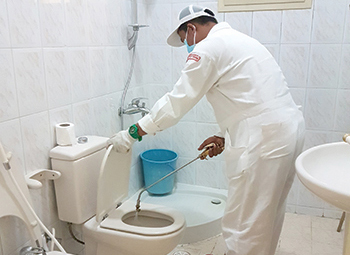Masa pulls the plug on roaches
MIRZA WAQAR AHMAD, an entomologist with Masa Establishment, suggests that an IPM approach should be adopted against cockroaches that use drains as an entry ticket to food supplies.
01 March 2018
Sanitation in drains and sewerage networks is generally a problem at food and beverage facilities, but one needs to be familiar with the fact that insect pests like cockroaches can live comfortably there, nourish on the junk inside, and enter facilities to contaminate the foodstuff and preparation areas.
Research shows that cockroaches get whatever they require – food and a suitable habitat – inside drains. They often live in the sewerage systems so they can get into the facilities easily from there. Cockroaches can gain access to facilities in other ways as well, such as from trash containers and nearby businesses that have low sanitation levels. Many times they are unknowingly introduced through packaging.
Once introduced into the facilities, poor sanitation practices allow the cockroaches to breed and multiply. Drains and sewers provide the ideal habitats for these pests to live, feed and breed.
Of the most common cockroach species, the American cockroach is the most challenging in relation to drainage systems as it prefers damp locations and access to water, but the Oriental and German cockroaches also have a tendency to be attracted to drains. German cockroaches are more likely to move in and out, rather than harbour in the drains but still pose a risk of infestation based on the sanitation conditions.
Moreover, drains can become favourable to any other insect pest activity if they are not cleaned regularly, if food particles are allowed into the drains, and if they get wet and then dry out.
The major concern is that cockroaches spread diseases. When they get into any food facility, they are already carrying numerous diseases and food contaminated by cockroaches can cause asthma, dysentery, salmonellosis, etc.
Besides diseases, these pests can have a negative impact on the employees’ disposition and can affect the overall impression of the food facility among clients, vendors and visitors.
 |
Masa service technicians ... well qualified. |
It is important for food facility employees to be aware of the rules and regulations of the Saudi Food and Drug Authority and ensure a hygienic environment as auditors also look for issues related to compliance with the rules suring third-party audits.
Renowned third-party auditor, AIB International, defines high standards related to pest management and focuses on the importance of the integrated pest management (IPM) approach.
Masa Establishment, a Saudi pest management company active in the kingdom since 1980, first conducts a thorough inspection of the facilities, offers economical solutions to the problem and then treats the insect pest infestations. It ensures follow-up visits are carried out on a weekly or monthly basis to eradicate the pest infestation and risk of occurrence elsewhere in the facilities. Following the standard procedures of AIB, a proper channel of communication with the client is maintained.
Masa believes the following techniques can help in exterminating the problems of cockroaches in any type of facility:
• Perimeter treatments: A proactive perimeter pest control is compulsory, reducing their habitat around the exterior perimeter, and creating a barrier spray on the foundation and around the entry points.
• Cleaning drainage and sewers: Bio-sanitation products can effectively clean drains in environments with chronic moisture and high organic load, and can help keep drains clean by digesting organic build-up. Maintaining drain cleanliness and using borate foams can provide continued pest suppression. Regular use of any cleaner is very important, as even those that don’t kill the insect will remove the conditions conducive to insect breeding.
• Pesticide treatment of drains: Having a good knowledge of pesticides is critical here as some, but not all, pesticides can be used in and around drains. Care should be taken when spraying in drains so that the operator doesn’t contaminate groundwater or areas where water drains out. Also, regular monthly spraying will ensure good control of the pest population build-up.
• Trapping devices in drains: This is a part of the IPM approach and prevents cockroaches from entering drains and subsequently the facility. The trap lets water flow out, but does not allow the insect in. Moreover, these kinds of traps can also eradicate gases and odours that can come up through drains and attract insects.
• Indoor inspections: Regular and detailed indoor inspections that cover all areas of the facilities connected to the drains is key to the effectiveness of the cleanliness and pest control programme. It is critical to inspect all areas where pests can hide in.
- T Nagadi expands as demand rises
- Viega makes joining easier
- Polypipe specified for key projects
- Masa pulls the plug on roaches



